On 1 February 1910, the ship Malwa docked briefly in Fremantle. On board was the world’s most famous entertainer, Harry Houdini – ‘the Handcuff King, and amazing prison-breaker’. He sailed on to Adelaide and then by train to Melbourne, arriving on 6 February.
The next night Houdini was on stage at the Melbourne Opera House. His show commenced with film of his dives into the Schuylkill River from Market Bridge, Philadelphia and from the Paris Morgue into the Seine, weighed down with ‘enough iron on him to satisfy the most exacting patron’.
Despite constantly being referred to as the Handcuff King, ‘not one solitary handcuff was seen’ on stage at this first Australian show. Instead of handcuffs, he escaped a straitjacket. He was then:
‘…tied into a large black bag, which was put into a chest. The chest was locked and roped, and put into a cabinet for about half a minute with a young lady. Houdini then came out of the cabinet, the chest was unlocked, the bag untied, and the young lady appeared, her two hands tied with the same piece of braid which had been on Houdini, and in a coat lent to Houdini by one of the audience.’ 1
Houdini’s real name was Erik Weisz. He was born in Budapest in 1874 and four years later he emigrated to America with his family. The family fell on hard times. Houdini became a spiritualist, magician and circus performer and took his name from the famous French magician, Jean-Eugène Robert-Houdin. His magic career spluttered along without great distinction (or reward) until he experimented with escapology.
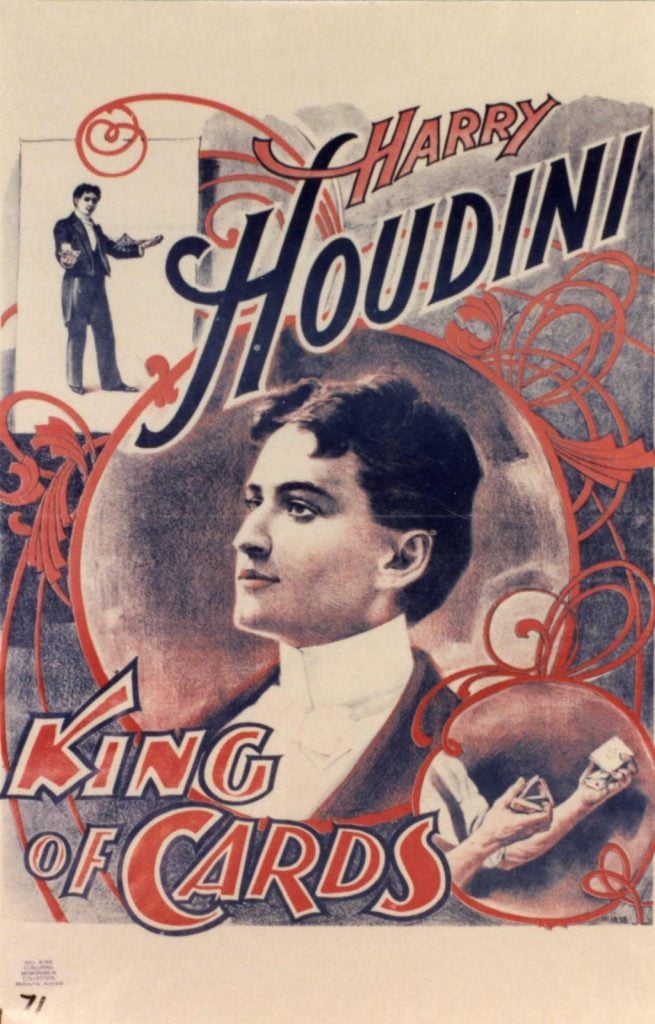

[At left] Harry Houdini King of Cards ALMA 93.2/71 Circa 1895, before Houdini found fame as an escapologist.
[At right] Harry Handcuff Houdini PC158/PC.2 An image circa 1919, at the height of his fame.
His handcuff escapes began to draw large audiences. In 1899, he was offered a spot with the Orpheum chain of vaudeville theatres. In 1900, he embarked on a very successful English tour and engagements in other European cities followed. His days of obscure poverty were behind him as he rose quickly to wealth and fame.
Some of his escapes were performed behind a curtain but he also undertook challenges from the public which were sometimes performed in full view of the audience.
He had, over the years, performed many challenges to publicise his act. Some of the most impressive were escapes from prison cells. In 1906, in Washington, he stripped and was thoroughly searched and locked in a cell. After 32 minutes, having escaped the cell and found his way through a number of other locked doors, he emerged fully clothed, to shake hands with Commissioner Biddle. 2
Famously in Melbourne on 17 February 1910, in front of an estimated 20,000 onlookers, a chained, handcuffed and padlocked Houdini leapt from Queen’s Bridge into the Yarra. With the Collingwood factories depositing all sorts of effluent upstream, it was a rather more fetid body of water than today. This proved no barrier to Houdini, emerging triumphant and unchained from the murky river.
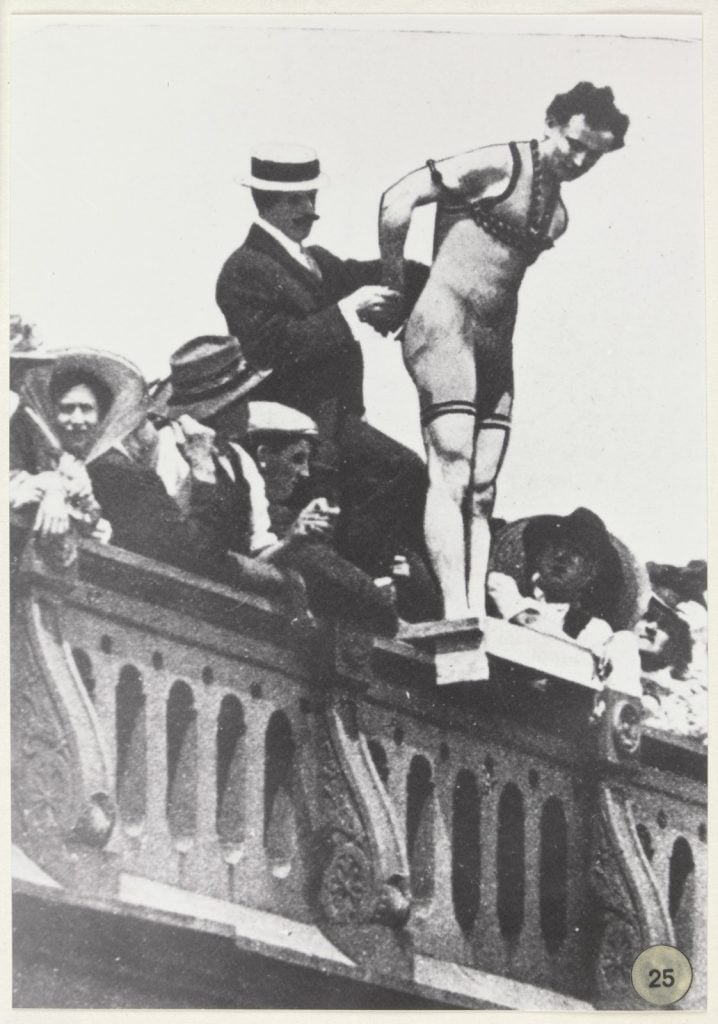
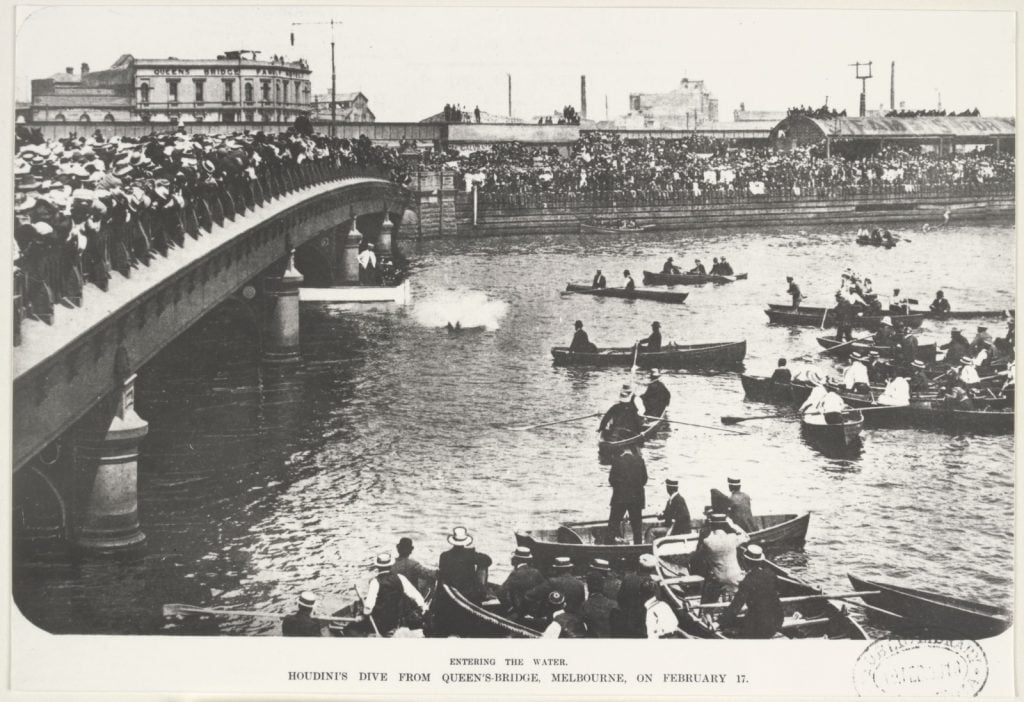

Images of Houdini’s leap into the Yarra, Harry Houdini in Melbourne P.7/NO.25, P.7/NO.26, P.7/NO.27
Houdini had brought a Voisin flying machine and a mechanic with him, with the express purpose of making the first controlled powered flight in Australia. This he did at Digger’s Rest on 18 March 1910, although there were other claimants to this title. 3
Magicians were huge stars, baffling eager audiences all over the world. It was a competitive business and Houdini was particularly concerned about imitators. In this first Australian interview, he remarked that he was annoyed that “some pugilist claimed as his own” Houdini’s milk can trick. In fact it wasn’t just any pugilist, but world famous champion boxer, Tommy Burns.
Kerry, Charles H. Burns-Johnson boxing contest, Sydney, 26 December 1908. Courtesy of National Library Australia
In December 1908, at Rushcutter’s Bay in Sydney in front of 20,000 fans, Burns lost his world title to African American fighter Jack Johnson in one of the century’s most famous sporting events. Rather bizarrely, Tommy Burns remained in Australia promoting the milk can escape, a trick he claimed to have purchased. His stage show was a mixed one, with the boxer recounting some of his great fights. The show culminated in Burns’ brother-in-law escaping from a locked, water-filled milk can.
Houdini remained annoyed at Tommy Burns. He did, though, perform the ‘milk can mystery’ himself during his tour.
Following his Melbourne performances, Houdini travelled to Sydney and performed at the Tivoli. He again sought challenges from the public, made flights in his plane, and escaped from chains after diving into the Domain Baths at the edge of Woolloomooloo Bay.
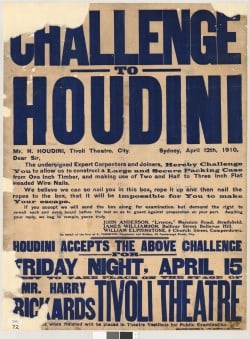
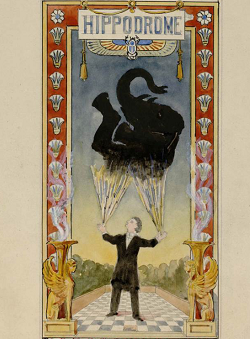
[Image at left] Challenge to Houdini, ALMA 93.2/72 See the newspaper report of this challenge.
[Image at right] Houdini’s Vanishing Elephant, Poster. Harry Ransom Center, University of Texas, Austin. Available through: Adam Matthew, Marlborough, Victorian Popular Culture 4
His final Australian performance was on 30 April 1910 at Sydney’s Tivoli Theatre. He remained a worldwide celebrity and headline performer. He even ventured into films.
In 1918, at the Hippodrome Theatre in New York, he performed his largest disappearing trick – the Vanishing Elephant. Docile elephant, ‘Jennie’, was led onto the vast stage and into an enormous box … and vanished. Houdini, who hadn’t initially found fame as a conjuror, was returning to his initial magician’s craft, albeit on a stupendously larger scale. 5
Magic is a performance and Houdini was a skilled performer. As he wrote:
‘…remember it is not the trick that is to be considered, but the style and manner in which it is presented.’ 6
But while he had techniques and tricks that allowed him to make ‘impossible’ escapes, he was also enormously inventive and an incredible athlete with great strength and dexterity. 7
After the First World War, spiritualism found a ready audience amongst the vast numbers of bereaved families who had lost loved ones in the carnage of the battlefields. One of the most famous was the creator of Sherlock Holmes, Arthur Conan Doyle. The author had lost a son during the war and was an ardent spiritualist. 8
In his pre-fame days, Houdini had dabbled in spiritualism and knew that it was, like all conjuring, a magic trick. In the days after the war, he saw spiritualism as not just a harmless entertainment but charlatanism taking advantage of unparalleled public grief.
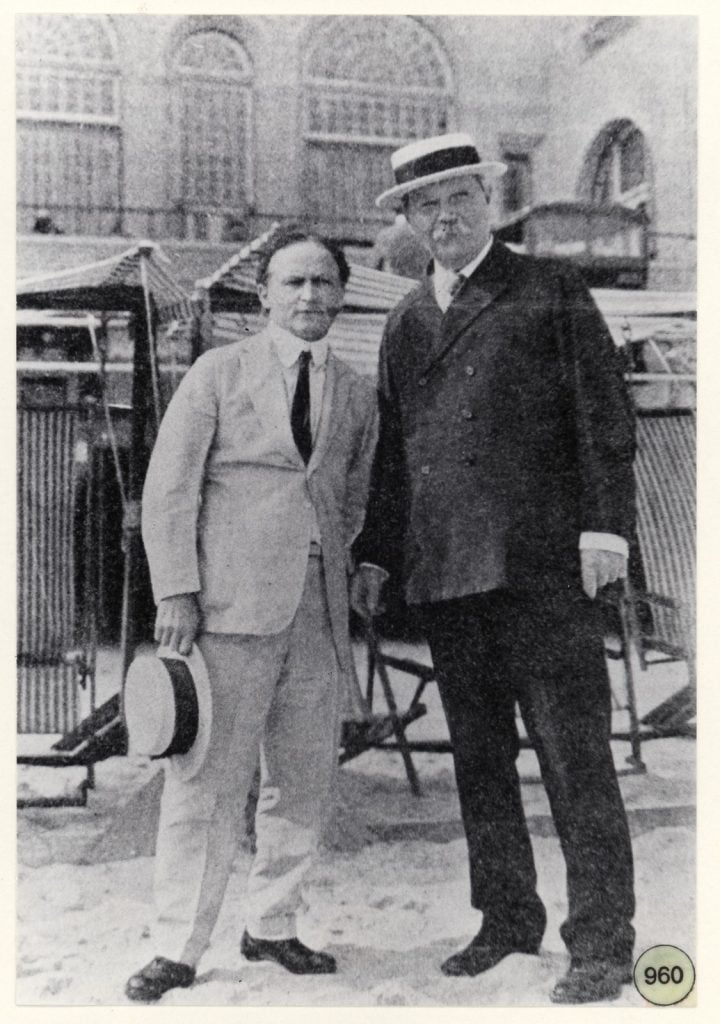
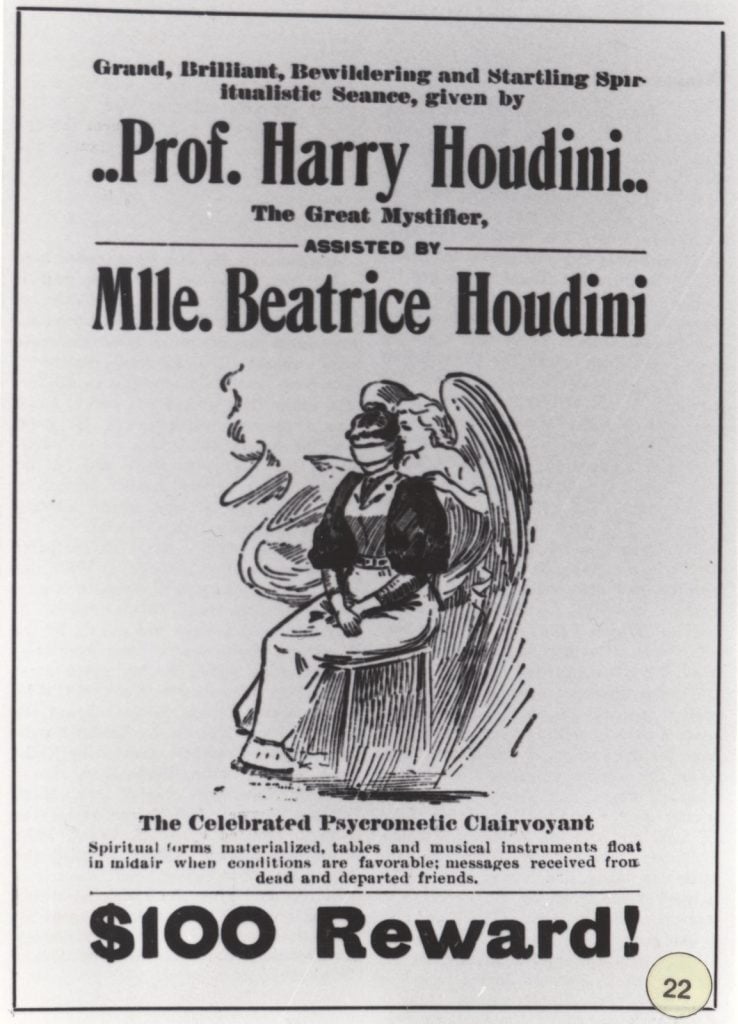
[At Left] Harry Houdini and Sir Arthur Conan Doyle P.288/NO.960
[At Right] Copy of a poster for Houdini’s early spiritualist act complete with magicians’ hyperbole – ‘The Great Mystifier’. Houdini is apparently a Professor while his wife Beatrice is a ‘psycrometic clairvoyant’. Bk.8/No.123
Houdini and Doyle had become friends, but it was a friendship that was increasingly tested by Houdini’s efforts to expose spiritualists as frauds. In 1924 Houdini’s book, A Magician Among the Spirits, was published. He immediately made clear his intentions.
Remembering his early days as a spiritualist, he acknowledged that he was ‘deceiving’ the public and, as a young man, didn’t:
‘see or understand the seriousness of trifling with such sacred sentimentality and the baneful result which inevitably followed. To me it was a lark’…
But as he grew older and experienced the loss of loved ones. he realised the:
‘seriousness of trifling with the hallowed reverence which the average human being bestows on the departed, and when I personally became afflicted with similar grief, I was chagrined that I should ever have been guilty of such frivolity and for the first time realized that it bordered on crime.’
Gladly would I embrace Spiritualism if it could prove its claims, but I am not willing to be deluded by the fraudulent impositions of so-called psychics, or accept as sacred reality any of the evidence that has been placed before me thus far. 9
Houdini continued to be a massive name in entertainment until his untimely death in 1926, aged 52.
While Houdini decried spiritualism as a fraud, he did, to some extent, hedge his bets. He and his wife Bess had a pact that when one partner died the other would hold an annual seance to try and contact the deceased partner from beyond the grave. After 10 years with no contact, Bess bid a final farewell. 10
Houdini’s fame has been enduring. Few proper names enter everyday conversation or are used as often as ‘Houdini’. Our PressReader database finds 58,000 recent instances of the word ‘Houdini’ in newspapers and magazines from around the world, all in different contexts but all related in some way back to Harry.
A random selection of Australian newspaper headlines from the 1990s
State Library Victoria holds one of the world’s great collections of conjuring resources – the W.G. Alma Conjuring Collection. For more about the collection, see our Magic & Magicians Research Guide. Also our Victorian Popular Culture database gives access to many original items on Houdini and magic
Footnotes
- Houdini, The Argus, 8 February 1910, p. 8.
- Through 6 locked doors: Houdini again foils efforts of police to keep him prisoner. Two strongholds of President of American Police Chiefs’ Association fail to hold Wizard of Handcuffs, The Washington Post, 6 January 1906, p. 2
- See our blog: Houdini flies in Diggers Rest and the Museums Victoria article: Pioneer flights at Diggers Rest Victoria
- For a description of this trick, see the New York Tribune, 6 January, 1918, p. 4
- The elephant has also been identified as ‘Fannie’ or ‘Lucy’.
- Houdini, H. (1910) Handcuff secrets. London: George Routledge and Sons, Limited. p. 6
- American Public Broadcasting Service/ American Experience: Houdini Escape Secrets Viewed 30 May 2024.
- Arthur Conan Doyle had a long standing interest in spiritualism. See our catalogue for many online articles
- Houdini, H. (1924). A Magician Among the Spirits. New York: Harper & Brothers, p. xi and Preface. See also digitised version.
- See also: Greene, Bryan For Harry Houdini, Séances and Spiritualism Were Just an Illusion, Smithsonian Magazine, October 28, 2021. Viewed 30 May 2024. Also various contemporary news articles including The Indianapolis times. 4 May 1928, p.1 & Imperial Valley Press. (El Centro, Calif.), 01 Nov. 1936, p.5

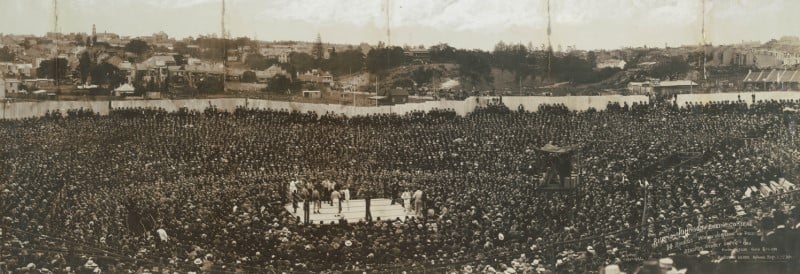
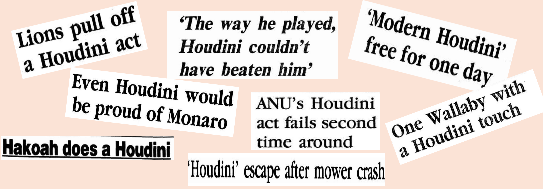

Thanks, Andrew! Did you know Houdini almost certainly learned some of his escapology – including his first handcuffery – from ‘Professor’ SS Baldwin, who also pioneered and toured a mesmerism and mind-reading act that was widely nicked, including by Anna Eva Fay? I wish we could have a drink with them all at the Princess Theatre bar.
I didn’t know that Kaz, thanks for the information
As a child (78) I had often heard about Houdini but never knew the fullest of his life.
Thank you for such an insightful resume of his life
Hello, Andrew. I love your blog, thankyou. I felt a connection as Houdini was the inspiration for Will Alma with whom I kept up a warm friendship until soon before he died. My last conversation was by phone while Chris and l were living in Adelaide! After I left SLV IN 1988 I kept up my association with him and his invalid wife (at whose funeral I spoke) by visiting him every Thursday night after dinner! Chris and I would sit in the bedroom with them both having a sherry ( he and. He’s) while I had a brandy and dry! Mr Alma and I would retreat to the other rooms while he showed me various new acquisitions! He was a character!!
Hi Fran, it’s so great to hear from you, thanks so much for sharing your memories of Will Alma. The Alma Collection is so iconic, we are very lucky to have it
Great article Andrew. Houdini’s repudiation of Spiritualism is fascinating.
Andrew, great article on an amazing performer and character who made the long trek to come to Australia. You mention Harry Houdini played on vaudeville in New York City and other US big cities, however what is not widely known in Australia is that he was often on the bill well below the highest paid Vaudeville star of the time, Ballarat born and Melbourne raised Bert Levy. Bert Levy was an on stage sketch artist who used humour to captivate audiences across America and Europe performing for royalty, the wealthy and the working class. In April 1916 Houdini wrote to Variety Magazine complaining Bert Levy was getting all the accolades in the press for offering free morning concerts to impoverished children in each city he performed. Houdini wanted the press to know he also offered performances gratis to the poor. Many of Bert Levy sketches before he left Australia in 1904 are in your wonderful State Library.
Thanks Jack, that’s very interesting information. I must read up on Bert Levy
Great article Andrew — many legendary performers and world figures passed through Melbourne in the late 19th and early 20th centuries, Mark Twain to name but one — WC Fields performed at the Melbourne Town Hall in 1903.